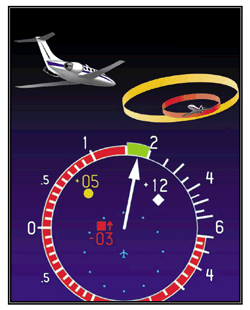Contributed by Matt Nelson, Duncan Avionics Satellite Operations Manager

TCAS indicator when aircraft pass dangerously close to each other. Source: Honeywell CAS 67A Pilot's Guide
The recent Traffic Collision Avoidance System (TCAS) 7.1 upgrade offers two major safety enhancements, which are significant enough to warrant mandates by more than one international organization. Additionally, an FAA statement has stirred speculation for the possibility of a future U.S. mandate.
As most of you surely know, TCAS involves communication between all aircraft equipped with an appropriate transponder. Each TCAS-equipped aircraft interrogates all other aircraft in a determined range about their position (via the 1030 MHz radio frequency), and all other aircraft reply to those interrogations (via 1090 MHz).
What you may not know is how the TCAS 7.1 upgrade affects aural warnings and TCAS reversals, and other minor enhancements that have caught the attention of international regulatory agencies.
Safety Enhancements
TCAS 7.1 is being offered as an upgrade by all of the major TCAS manufacturers and makes two important safety enhancements.
- Aural Warning Change – The current TCAS II aural warning will be changed from “Adjust Vertical Speed, Adjust” to “Level Off, Level Off”.
- TCAS Reversals – TCAS 7.1 corrects missed and late TCAS reversals. TCAS reversals were introduced in TCAS 7.0 to adapt to changing situations where the original sense had clearly become the wrong thing to do, in particular when a pilot decides not to follow the Resolution Advisory (RA), or is instructed by Air Traffic Control (ATC) to perform a particular maneuver. The solution in Change 7.1 introduces improvements to the current reversal logic that addresses the late issuance of reversal RAs and potential failures to initiate reversal RAs.
Other Minor Enhancements
- Corrects issue when descending through 1000 ft. AGL.
- Modifies the “Datalink Capability Report” (Status report sent by the TCAS processor to the Mode S transponder) to tell the systems that the TCAS processor is hybrid-surveillance-capable.
- Allows for the transmission of the TCAS processor part number and software level.
- Corrects TCAS multi-aircraft logic issues, which reduces the risk of “close-encounters” of multiple aircraft in RVSM airspace.
International Mandates
These enhancements are significant enough to warrant mandates by both the International Civil Aviation Organization (ICAO) and the European Aviation Safety Agency (EASA). ICAO has mandated TCAS 7.1 by January 1, 2014 for forward fit aircraft and January 1, 2017 for retrofit aircraft. By comparison, EASA required all forward fit aircraft to be mandated by March 1, 2012, with retrofit aircraft to follow by December 1, 2015.
The U.S. FAA is reportedly a “strong supporter” of TCAS 7.1 and has issued the following statement:
“The latest version of software for TCAS II is version 7.1. To ensure compatibility with international standards, the FAA encourages the installation of this software as soon as practical.”
This statement has stirred thoughts among the avionics manufacturing community that TCAS 7.1 may be mandated in the US.
The certification path for TCAS 7.1-modified units will be accomplished through a Supplemental Type Certificate (STC), Type Certificate (TC) or in some cases a Major Repair Alteration (MRA) project with a re-write of the Airplane Flight Manual Supplement (AFMS). To determine the certification path for your aircraft, please have a copy of your AFMS handy and call an avionics professional within the Duncan Avionics satellite network.
Straight Talk About ADS-B also includes a section on TCAS II Version 7.1, with discussion on how the two systems are linked.
Matt Nelson serves as the Duncan Avionics Satellite Operations Manager at Duncan Aviation's Lincoln, Neb. full-service facility. His aviation career began in 1987.


